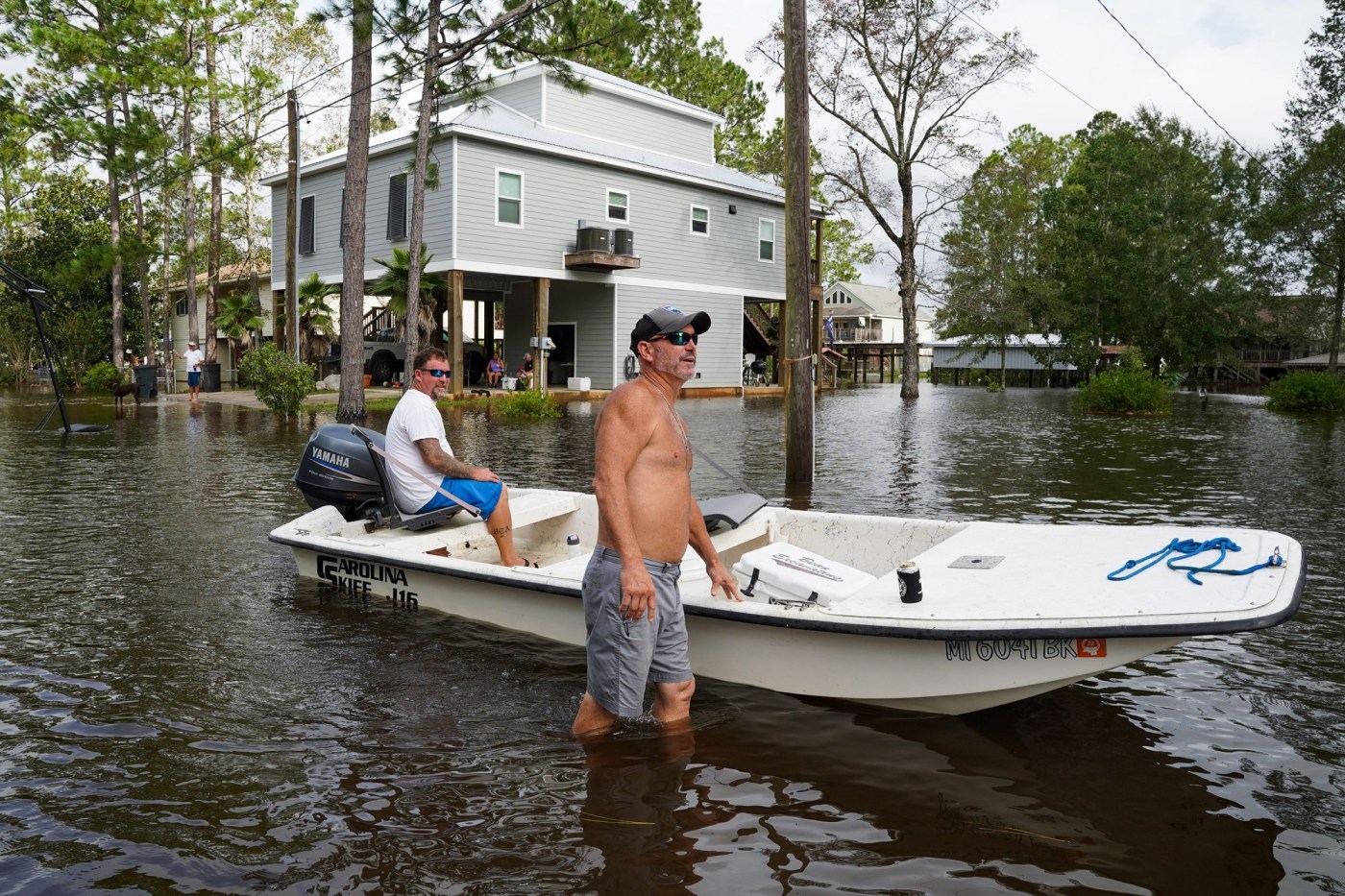Alex Brown | (TNS) Stateline.org
In the coming years, climate change could force Americans from their homes, not just by raising sea levels, worsening wildfires and causing floods — but also by putting insurance coverage out of reach.
In places including California, Florida and Louisiana, some homeowners are finding it nearly impossible to find an insurance company that will cover their property. Others have seen their premiums climb so high that they can no longer pay. Experts say the trend is spreading throughout the country as natural disasters increase.
Most mortgage lenders require homeowners to maintain insurance. Without access to coverage, millions of Americans could find themselves forced to reconsider where they live. Consumer advocates say long-overdue conversations about development in areas prone to natural disasters are being driven by property insurers, not governments.
“Insurance companies have basically become our land-use officials,” said Doug Heller, director of insurance with the Consumer Federation of America, a research and advocacy nonprofit. “In 2023, the industry suddenly seemed to wake up and say, ‘There’s climate change, forget all those times we’ve nodded our head yes and told you that you can live there.’”
As the crisis escalates, state leaders are desperately trying to convince insurance companies to stick around. States are offering them more flexibility to raise premiums or drop certain homes from coverage, fast-tracking rate revisions and making it harder for residents to sue their insurance company.
Meanwhile, a flood of new policyholders are joining state-backed insurance “plans of last resort,” leaving states to assume more of the risk on behalf of residents who can’t find coverage in the private sector.
Industry leaders note that insurance companies have been hammered by heavy payouts — last year, 28 separate U.S. natural disasters caused at least $1 billion each in damage, according to federal figures— and say they simply can’t afford to provide coverage in the areas that face the highest risk.
Disaster costs are soaring. In the last five years, there have been 102 disaster events in the United States that caused at least $1 billion in damage. In the entire decade of the 1990s, there were 57 billion-dollar events (adjusted for inflation), and in the 1980s there were 33.
Natural disasters are increasing at the same time risk-prone areas are becoming ever more populated, and as property values are climbing. The price of repairs and replacement have skyrocketed due to inflation, workforce and supply chain issues. Insurers say costs also have been driven by an uptick in litigation and fraud.
“We’re experiencing record-breaking losses as it relates to natural disasters,” said Adam Shores, senior vice president for state government relations with the American Property Casualty Insurance Association, an industry group. “We want to be there, but when the math doesn’t work for a company, they have to make those decisions.”
While the insurance crisis is most acute in certain coastal states, climate experts say every region will face similar challenges, especially as severe storms batter the middle of the country. While some states have made marginal gains in stabilizing the insurance market, some experts say that progress may be short-lived.
“Insurers are the climate change canary in the coal mine,” said Dave Jones, the former insurance commissioner in California and director of the Climate Risk Initiative at the University of California, Berkeley’s Center for Law, Energy, & the Environment. “While these policy and regulatory interventions might help in the short run, they’re likely to be overwhelmed by the increasing risk and loss.”
‘The perfect storm’
In some hard-hit states, policymakers have focused on giving insurance companies more flexibility to adjust their rates and coverage options.
Four hurricanes walloped Louisiana in 2020 and 2021, causing $23 billion in insured losses. Twelve insurance companies became insolvent and dozens left the state. Residents in southern Louisiana especially have struggled to find coverage, and some have moved elsewhere because they couldn’t afford their premiums.
“It’s the perfect storm,” said Louisiana state Rep. Gabe Firment, a Republican. “We just do not have companies willing to write business in Louisiana right now, and you can’t blame them.”
Firment sponsored a measure, enacted this year, repealing a state rule that had blocked companies from dropping long-standing customers. Those dropped can join a state-run plan. Lawmakers hope that — given the ability to cancel the highest-risk policies — insurance companies will remain in the state and avoid massive rate hikes on their remaining customers.
Legislators passed a suite of other laws aimed at the crisis, speeding up the process for insurers to adjust their rates, extending a grant program to help residents fortify their homes and giving companies more time to pay out claims. Firment said the changes are designed to attract more companies back to the state, “but if we get two or three hurricanes this year, all bets are off.”
In California, many major insurers have canceled policies or stopped accepting new applications due to wildfire risk. Regulators there have proposed a rule that would allow companies to incorporate climate change projections into the models they use to set their rates.
“Insurers are not going to continue to write in every market if they can’t price accurately,” said Mark Friedlander, director of corporate communications with the Insurance Information Institute, an industry-backed research group.
Meanwhile, Democratic Gov. Gavin Newsom has put forth a measure that would speed up regulators’ approval of the rate revisions proposed by insurance companies. While seeking to give insurers more flexibility on rates, California leaders also have sought to protect residents by establishing a one-year moratorium on policy cancellations in disaster areas following a wildfire.
Officials at the state Department of Insurance did not respond to Stateline interview requests.
Homeowners’ insurance rates in Texas spiked 23% last year, twice the national average. The state has endured a myriad of disasters in recent years, but consumer advocates fear insurers are weaponizing climate change to jack up rates and demand looser regulations.
“[Insurance companies] are putting a gun to our heads, telling us, ‘Do it our way or we’ll pull up stakes,’” said Ware Wendell, executive director of Texas Watch, a nonprofit advocacy group. “They’re going to cherry-pick the country and only insure parts of the country that have less climate risk.”
The Texas Department of Insurance did not grant a Stateline interview request.
‘Last resort’
In several states, homeowners who can’t find private coverage are joining state-run plans. Originally intended to be a last-ditch option, because they generally offer limited coverage, these plans are seeing more and more residents signing up.
Florida has seen more than 1 million residents join the plan offered by the state-run Citizens Property Insurance Corporation. The plan, which is meant to be a “last resort” option, now stands as the largest in the state.
Insurance rates in Florida have climbed to four times the national average, following hurricanes Ian and Nicole in 2022. The state also has seen an uptick in claims lawsuits that insurance companies characterize as legal abuse.
Legislators changed state law in 2022 to disincentivize such lawsuits, ending homeowners’ ability to collect attorneys fees from insurers in claims disputes. State regulators say insurance rates have stabilized in 2024, and new companies are joining the market. The Florida Office of Insurance Regulation did not grant an interview request.
But some lawmakers say state leaders are eager to help insurance companies while ignoring the underlying issue of climate change.
“Stabilization is important, but [premiums] have stabilized at high rates,” said state Rep. Anna Eskamani, a Democrat. “Floridians can’t afford Florida anymore, and if we’re not taking climate change seriously, then we’re missing the point.”
Eskamani called for leaders to change land-use policies to limit development in high-risk areas.
Even as some Florida homeowners are now shifting from the state-run plan back to the private market, industry experts say the nationwide surge in state-backed policies is troubling. If such plans exhaust their reserves, states impose an assessment on either all insurance companies or all individual policyholders — known in Florida as the “hurricane tax.”
Jones, the former California insurance commissioner, noted that insurers there are worried that growing wildfire risk could force them to bail out the state plan. Nearly 400,000 Californians rely on the state plan for insurance, and state officials have warned that a catastrophic event could wipe out its reserves.
While Californians struggle to find insurance on the private market, Jones called out the insurers that are dropping policies even as they retain financial ties to fossil fuel companies.
“Why are insurers investing in and writing insurance for the very industry that’s making it increasingly challenging for them to write insurance in certain parts of the country?” he said.
In Colorado, lawmakers voted last year to create a state-backed insurance plan like those in more than 30 other states. State Sen. Dylan Roberts, the Democrat who sponsored the bill, said he heard from constituents who were getting dropped by their insurers following the Marshall Fire that swept through Boulder County in 2021.
Related Articles
Gov. Newsom details plan to fix home insurance market woes, consumer advocate says it will cost consumers ‘billions’
Alameda County DA sues Farmers Insurance over ‘widespread scheme’ to underinsure homes
Home insurance companies may use aerial images to drop policies
Newsom’s latest insurance move could help Californians avoid canceled policies — but they’ll have to pay
Jury awards California sisters $18 million from insurance company that offered only $5,000 for storm damage
“We’re going to have more and more Coloradoans every year who are unable to find insurance for their property on the private market,” he said. “To have an insurer of last resort is something we hope isn’t used widely, but it’s something we need to have.”
Some consumer advocates believe states will have to get more involved. Amy Bach, executive director of United Policyholders, a nonprofit that advocates for insurance customers, said governments face the same difficult risk calculations as private companies but are tax-exempt and don’t face the same pressures to return high profit margins to shareholders.
“Publicly supported insurance programs are here to stay,” she said. “It behooves us to build them as smart as we can.”
In Washington state, regulators say they have only a few hundred policies on the state-backed plan, a sign that residents can still access coverage on the private market. David Forte, senior property and casualty policy adviser with the Office of the Insurance Commissioner, said the agency has added actuarial staff to speed up insurers’ rate revision approvals.
He also credited the work of state leaders who have invested millions to reduce wildfire risk. But he cited a 2022 wildfire that nearly swept through the town of Index, before shifting winds changed its direction.
“If that had happened, I think our property market would be different,” he said. “Are we just one bad event away? Probably.”
Stateline is part of States Newsroom, a national nonprofit news organization focused on state policy.
©2024 States Newsroom. Visit at stateline.org. Distributed by Tribune Content Agency, LLC.












